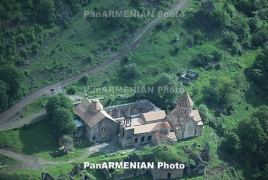
Azerbaijan’s government has announced that it intends to erase Armenian inscriptions on religious sites in the territory that it reclaimed in the 2020 war with Armenia, Eurasianet reports.
It justified the move by arguing that the churches in fact were originally the heritage of Caucasian Albania, an ancient kingdom once located in what is now Azerbaijan. The theory, which is not supported by historians, has long been propagated by nationalist Azerbaijani historians and has been embraced by the current government in Baku.
Minister of Culture Anar Karimov told a press briefing on February 3 that a working group has been established which will be responsible for removing “the fictitious traces written by Armenians on Albanian religious temples.”
“We are going to inspect those places with the working group members, and after the inspection, we will consider our next steps,” Karimov said. While he did not identify who will be in the working group, the minister stated that the group will consist of “both local and international experts.”
The Albanian theory was first developed in the 1950s by Azerbaijani historian Ziya Buniyatov, who claimed that Armenian inscriptions in churches on Azerbaijani territory were later additions to Albanian churches. According to this theory, they were only “Armenianized” following large-scale Armenian emigration to the region after Russia won control of the territory from Azerbaijan in the beginning of the 19th century.
The announcement of the working group is the first concrete step that the government has taken overtly promising to erase Armenian traces on the churches now under their control.
The ongoing threats to Armenian cultural sites have drawn international concern. Shortly after the war, Aliyev promised Russian President Vladimir Putin that he would protect Christian sites in the newly retaken territories. UNESCO issued a statement warning Armenia and Azerbaijan that “damage to cultural property belonging to any people whatsoever means damage to the cultural heritage of all mankind.” Efforts by UNESCO to send a mission to Karabakh to examine the cultural heritage sites have long been stalled, however.
In December, the International Court of Justice (ICJ) ruled that Azerbaijan must “take all necessary measures to prevent and punish acts of vandalism and desecration affecting Armenian cultural heritage, including but not limited to churches and other places of worship, monuments, landmarks, cemeteries and artifacts.”
Armenian officials did not immediately react to the Azerbaijani announcement. Ministry of Foreign Affairs spokesperson Vahan Hunanyan told Eurasianet that they had no comment on this specific issue now but that they had repeatedly emphasized the importance of preserving Armenian cultural heritage.
Concerns about the preservation of cultural sites in Nagorno-Karabakh are made all the more urgent by the Azerbaijani government’s history of systemically destroying indigenous Armenian heritage—acts of both warfare and historical revisionism. The Azerbaijani government has secretly destroyed a striking number of cultural and religious artifacts in the late 20th century. Within Nakhichevan alone, a historically Armenian enclave in Azerbaijan, Azerbaijani forces destroyed at least 89 medieval churches, 5,840 khachkars (Armenian cross stones) and 22,000 historical tombstones between 1997 and 2006.

